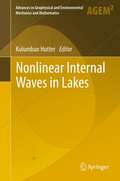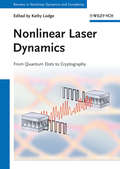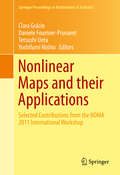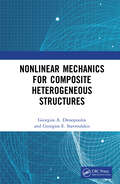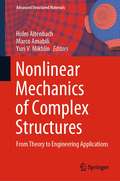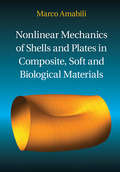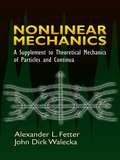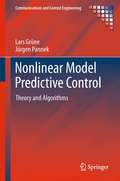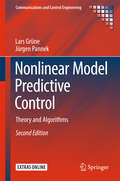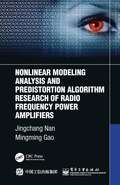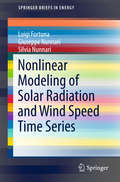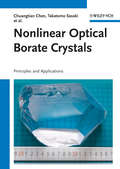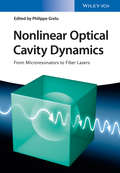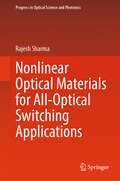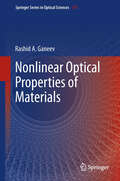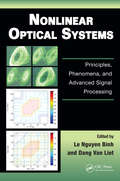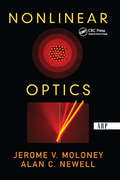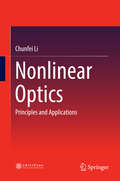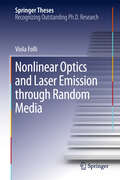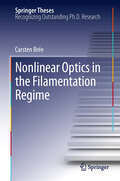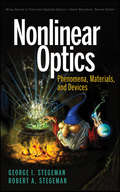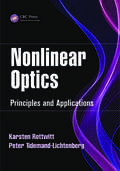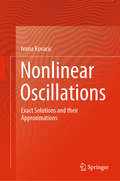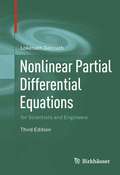- Table View
- List View
Nonlinear Internal Waves in Lakes
by Kolumban HutterInternal wave dynamics in lakes (and oceans) is an important physical component of geophysical fluid mechanics of 'quiescent' water bodies of the Globe. The formation of internal waves requires seasonal stratification of the water bodies and generation by (primarily) wind forces. Because they propagate in basins of variable depth, a generated wave field often experiences transformation from large basin-wide scales to smaller scales. As long as this fission is hydrodynamically stable, nothing dramatic will happen. However, if vertical density gradients and shearing of the horizontal currents in the metalimnion combine to a Richardson number sufficiently small (< ¼), the light epilimnion water mixes with the water of the hypolimnion, giving rise to vertical diffusion of substances into lower depths. This meromixis is chiefly responsible for the ventilation of the deeper waters and the homogenization of the water through the lake depth. These processes are mainly formed as a result of the physical conditions, but they play biologically an important role in the trophicational state of the lake.
Nonlinear Laser Dynamics: From Quantum Dots to Cryptography (Annual Reviews of Nonlinear Dynamics and Complexity
by Heinz Georg Schuster Kathy LüdgeA distinctive discussion of the nonlinear dynamical phenomena of semiconductor lasers. <P><P>The book combines recent results of quantum dot laser modeling with mathematical details and an analytic understanding of nonlinear phenomena in semiconductor lasers and points out possible applications of lasers in cryptography and chaos control. This interdisciplinary approach makes it a unique and powerful source of knowledge for anyone intending to contribute to this field of research. By presenting both experimental and theoretical results, the distinguished authors consider solitary lasers with nano-structured material, as well as integrated devices with complex feedback sections. In so doing, they address such topics as the bifurcation theory of systems with time delay, analysis of chaotic dynamics, and the modeling of quantum transport. They also address chaos-based cryptography as an example of the technical application of highly nonlinear laser systems.
Nonlinear Maps and their Applications
by Clara Grácio Daniele Fournier-Prunaret Tetsushi Ueta Yoshifumi NishioIn the field of Dynamical Systems, nonlinear iterative processes play an important role. Nonlinear mappings can be found as immediate models for many systems from different scientific areas, such as engineering, economics, biology, or can also be obtained via numerical methods permitting to solve non-linear differential equations. In both cases, the understanding of specific dynamical behaviors and phenomena is of the greatest interest for scientists. This volume contains papers that were presented at the International Workshop on Nonlinear Maps and their Applications (NOMA 2011) held in Évora, Portugal, on September 15-16, 2011. This kind of collaborative effort is of paramount importance in promoting communication among the various groups that work in dynamical systems and networks in their research theoretical studies as well as for applications. This volume is suitable for graduate students as well as researchers in the field.
Nonlinear Mechanics for Composite Heterogeneous Structures
by Georgios E. Stavroulakis Georgios A. DrosopoulosNonlinear Mechanics for Composite Heterogeneous Structures applies both classical and multi-scale finite element analysis to the non-linear, failure response of composite structures. These traditional and modern computational approaches are holistically presented, providing insight into a range of non-linear structural analysis problems. The classical methods include geometric and material non-linearity, plasticity, damage and contact mechanics. The cutting-edge formulations include cohesive zone models, the Extended Finite Element Method (XFEM), multi-scale computational homogenization, localization of damage, neural networks and data-driven techniques. This presentation is simple but efficient, enabling the reader to understand, select and apply appropriate methods through programming code or commercial finite element software. The book is suitable for undergraduate studies as a final year textbook and for MSc and PhD studies in structural, mechanical, aerospace engineering and material science, among others. Professionals in these fields will also be strongly benefited. An accompanying website provides MATLAB codes for two-dimensional finite element problems with contact, multi-scale (FE2) and non-linear XFEM analysis, data-driven and machine learning simulations.
Nonlinear Mechanics of Complex Structures: From Theory to Engineering Applications (Advanced Structured Materials #157)
by Holm Altenbach Yuri V. Mikhlin Marco AmabiliThis book covers different topics of nonlinear mechanics in complex structures, such as the appearance of new nonlinear phenomena and the behavior of finite-dimensional and distributed nonlinear systems, including numerous systems directly connected with important technological problems.
Nonlinear Mechanics of Shells and Plates in Composite, Soft and Biological Materials
by Marco AmabiliThis book presents the most recent advances on the mechanics of soft and composite shells and their nonlinear vibrations and stability, including advanced problems of modeling human vessels (aorta) with fluid-structure interaction. It guides the reader into nonlinear modelling of shell structures in applications where advanced composite and complex biological materials must be described with great accuracy. To achieve this goal, the book presents nonlinear shell theories, nonlinear vibrations, buckling, composite and functionally graded materials, hyperelasticity, viscoelasticity, nonlinear damping, rubber and soft biological materials. Advanced nonlinear shell theories, not available in any other book, are fully derived in a simple notation and are ready to be implemented in numerical codes. The work features a blend of the most advanced theory and experimental results, and is a valuable resource for researchers, professionals and graduate students, especially those interested in mechanics, aeronautics, civil structures, materials, bioengineering and solid matter at different scales.
Nonlinear Mechanics: A Supplement to Theoretical Mechanics of Particles and Continua
by Alexander L. Fetter John Dirk WaleckaIn their prior Dover book, Theoretical Mechanics of Particles and Continua, Alexander L. Fetter and John Dirk Walecka provided a lucid and self-contained account of classical mechanics, together with appropriate mathematical methods. This supplement--an update of that volume--offers a bridge to contemporary mechanics.The original book's focus on continuum mechanics--with chapters on sound waves in fluids, surface waves on fluids, heat conduction, and viscous fluids--forms the basis for this supplement's discussion of nonlinear continuous systems. Topics include linearized stability analysis; a detailed examination of the Rayleigh-Bénard problem, from its formulation to issues of linearized theory of convective instability and expansion in Fourier modes; and the direct derivation of Lorenz equations for simple physical configuration. The first half of the original text deals with particle mechanics, and this supplement returns to the study of systems with a finite number of degrees of freedom. A concluding section presents a series of problems that reinforce the supplement's teachings.
Nonlinear Model Predictive Control
by Jürgen Pannek Lars GrüneNonlinear Model Predictive Control is a thorough and rigorous introduction to nonlinear model predictive control (NMPC) for discrete-time and sampled-data systems. NMPC is interpreted as an approximation of infinite-horizon optimal control so that important properties like closed-loop stability, inverse optimality and suboptimality can be derived in a uniform manner. These results are complemented by discussions of feasibility and robustness. NMPC schemes with and without stabilizing terminal constraints are detailed and intuitive examples illustrate the performance of different NMPC variants. An introduction to nonlinear optimal control algorithms gives insight into how the nonlinear optimisation routine - the core of any NMPC controller - works. An appendix covering NMPC software and accompanying software in MATLAB® and C++(downloadable from www.springer.com/ISBN) enables readers to perform computer experiments exploring the possibilities and limitations of NMPC.
Nonlinear Model Predictive Control
by Jürgen Pannek Lars GrüneNonlinear Model Predictive Control is a thorough and rigorous introduction to nonlinear model predictive control (NMPC) for discrete-time and sampled-data systems. NMPC is interpreted as an approximation of infinite-horizon optimal control so that important properties like closed-loop stability, inverse optimality and suboptimality can be derived in a uniform manner. These results are complemented by discussions of feasibility and robustness. NMPC schemes with and without stabilizing terminal constraints are detailed and intuitive examples illustrate the performance of different NMPC variants. An introduction to nonlinear optimal control algorithms gives insight into how the nonlinear optimisation routine - the core of any NMPC controller - works. An appendix covering NMPC software and accompanying software in MATLAB® and C++(downloadable from www. springer. com/ISBN) enables readers to perform computer experiments exploring the possibilities and limitations of NMPC.
Nonlinear Modeling Analysis and Predistortion Algorithm Research of Radio Frequency Power Amplifiers
by Jingchang Nan Mingming GaoThis book is a summary of a series of achievements made by the authors and colleagues in the areas of radio frequency power amplifier modeling (including neural Volterra series modeling, neural network modeling, X-parameter modeling), nonlinear analysis methods, and power amplifier predistortion technology over the past 10 years. The book is organized into ten chapters, which respectively describe an overview of research of power amplifier behavioral models and predistortion technology, nonlinear characteristics of power amplifiers, power amplifier behavioral models and the basis of nonlinear analysis, an overview of power amplifier predistortion, Volterra series modeling of power amplifiers, power amplifier modeling based on neural networks, power amplifier modeling with X-parameters, the modeling of other power amplifiers, nonlinear circuit analysis methods, and predistortion algorithms and applications.Blending theory with analysis, this book will provide researchers and RF/microwave engineering students with a valuable resource.
Nonlinear Modeling of Solar Radiation and Wind Speed Time Series
by Luigi Fortuna Giuseppe Nunnari Silvia NunnariThis brief is a clear, concise description of the main techniques of time series analysis --stationary, autocorrelation, mutual information, fractal and multifractal analysis, chaos analysis, etc. -- as they are applied to the influence of wind speed and solar radiation on the production of electrical energy from these renewable sources. The problem of implementing prediction models is addressed by using the embedding-phase-space approach: a powerful technique for the modeling of complex systems. Readers are also guided in applying the main machine learning techniques for classification of the patterns hidden in their time series and so will be able to perform statistical analyses that are not possible by using conventional techniques. The conceptual exposition avoids unnecessary mathematical details and focuses on concrete examples in order to ensure a better understanding of the proposed techniques. Results are well-illustrated by figures and tables.
Nonlinear Optical Borate Crystals: Principals and Applications
by Masashi Yoshimura Zheshuai Lin Yusuke Mori Rukang Li Gerard Aka Chuangtian Chen Jiyang Wang Yushi Kaneda Takatamo Sasaki Yincheng Wu Zhangui HuThis clear and self-contained review of the last four decades of research highlights in the hot field of nonlinear optical (NLO) crystals, particularly of borate-based ultraviolet and deep-ultraviolet NLO crystals, covers three major subjects: the structure-property relationship in borate crystals, the structural and optical characteristics of various promising borate crystals, and their fruitful applications in a wide range of scientific and technological fields. Edited by the discoverers and users of these optical borate crystals, this is a readily accessible reading for semiconductor, applied and solid state physicists, materials scientists, solid state chemists, manufacturers of optoelectronic devices, and those working in the optical industry.
Nonlinear Optical Cavity Dynamics
by Philippe GreluBy recirculating light in a nonlinear propagation medium, the nonlinear optical cavity allows for countless options of light transformation and manipulation. In passive media, optical bistability and frequency conversion are central figures. In active media, laser light can be generated with versatile underlying dynamics. Emphasizing on ultrafast dynamics, the vital arena for the information technology, the soliton is a common conceptual keyword, thriving into its modern developments with the closely related denominations of dissipative solitons and cavity solitons. Recent technological breakthroughs in optical cavities, from micro-resonators to ultra-long fiber cavities, have entitled the exploration of nonlinear optical dynamics over unprecedented spatial and temporal orders of magnitude. By gathering key contributions by renowned experts, this book aims at bridging the gap between recent research topics with a view to foster cross-fertilization between research areas and stimulating creative optical engineering design.
Nonlinear Optical Materials for All-Optical Switching Applications (Progress in Optical Science and Photonics #33)
by Rajesh SharmaThis book highlights the background and fundamentals of nonlinear optical materials in relation to all-optical switching applications. It explains major aspects of nonlinear refractive index and the nonlinear absorption phenomena which are essential to decide the figure-of-merit of various materials for the all-optical switching. Autocorrelation technique, frequency-resolved optical gating, spectral phase interferometry for direct electric-field reconstruction, grating-eliminated no-nonsense observation of ultrafast incident laser light e-fields are discussed to measure the temporal and spectral profiles of the ultrafast pulsed lasers. Advanced nonlinear optical characterization methods such as single- and dual-arm Z-scan, pump-probe and beam deflection techniques are also discussed at length. The transmission signal obtained in the majority of the nonlinear optical effects is found to be weak which creates hiccups to obtain faster switching speeds. Various solutions are discussed to overcome these existing limitations of the all-optical switching-based devices. Optical nonlinearities in semiconductors, organic molecules and challenges in all-optical switching devices are also addressed in the book.
Nonlinear Optical Properties of Materials
by Rashid A. GaneevThis book is mostly concerned on the experimental research of the nonlinear optical characteristics of various media, low- and high-order harmonic generation in different materials, and formation, and nonlinear optical characterization of clusters. We also demonstrate the inter-connection between these areas of nonlinear optics. Nonlinear optical properties of media such as optical limiting can be applied in various areas of science and technology. To define suitable materials for these applications, one has to carefully analyse the nonlinear optical characteristics of various media, such as the nonlinear refractive indices, coefficients of nonlinear absorption, saturation absorption intensities, etc. Knowing the nonlinear optical parameters of materials is also important for describing the propagation effects, self-interaction of intense laser pulses, and optimisation of various nonlinear optical processes. Among those processes one can admit the importance of the studies of the frequency conversion of coherent laser sources. The area of interest for nonlinear optical characterization of materials is also closely related with new field of nanostructures formation and application during laser-matter interaction. We show how the nonlinear optical analysis of materials leads to improvement of their high-order nonlinear optical response during the interaction with strong laser fields. Ablation-induced nanoparticles formation is correlated with their applications as efficient sources of coherent short-wavelength photons. From other side, recent achievements of harmonic generation in plasmas are closely related with the knowledge of the properties of materials in the laser plumes. All of these studies are concerned with the low-order nonlinear optical features of various materials. The novelty of the approach developed in present book is related with inter-connection of those studies with each other.
Nonlinear Optical Systems
by Luigi Lugiato Franco Prati Massimo BrambillaGuiding graduate students and researchers through the complex world of laser physics and nonlinear optics, this book provides an in-depth exploration of the dynamics of lasers and other relevant optical systems, under the umbrella of a unitary spatio-temporal vision. Adopting a balanced approach, the book covers traditional as well as special topics in laser physics, quantum electronics and nonlinear optics, treating them from the viewpoint of nonlinear dynamical systems. These include laser emission, frequency generation, solitons, optically bistable systems, pulsations and chaos and optical pattern formation. It also provides a coherent and up-to-date treatment of the hierarchy of nonlinear optical models and of the rich variety of phenomena they describe, helping readers to understand the limits of validity of each model and the connections among the phenomena. It is ideal for graduate students and researchers in nonlinear optics, quantum electronics, laser physics and photonics.
Nonlinear Optical Systems: Principles, Phenomena, and Advanced Signal Processing (Optics And Photonics Ser.)
by Le Nguyen Binh Dang Van LietNonlinear Optical Systems: Principles, Phenomena, and Advanced Signal Processing is a simplified overview of the evolution of technology associated with nonlinear systems and advanced signal processing. This book's coverage ranges from fundamentals to phenomena to the most cutting-edge aspects of systems for next-generation biomedical monitoring an
Nonlinear Optics
by Alan NewellNonlinear optics, the study of the nonlinear effects associated with the propagation of light through matter, is so scientifically rich and technologically promising that it is destined to become one of the most important areas of scientific research into the next century. This book is written for graduate students or anyone interested in getting a unified picture of this emerging field.Nonlinear Optics allows the reader to see all these manifestations of the light-matter interaction as part of the unified whole. Professors Newell and Moloney show how to use these simple equations both to gain a better understanding of the physical processes involved and to deal with the practical applications. Specific topics include: the notion of the nonlinear refractive index and self-phase modulation, the propagation and use of nonlinear waves and solitons in optical fibers and waveguides, two-and-three lasers, optical bistability, the interaction of co- and counter-propagating beams, stimulated Raman and Brillouin scattering, and self-induced transparency. The final chapter discusses mathematical and computational methods such as multiple time scaling, linear and nonlinear wave propagation, solitons, numerical methods, and useful software packages.
Nonlinear Optics
by Chunfei LiThis book reflects the latest advances in nonlinear optics. Besides the simple, strict mathematical deduction, it also discusses the experimental verification and possible future applications, such as the all-optical switches. It consistently uses the practical unit system throughout. It employs simple physical images, such as "light waves" and "photons" to systematically explain the main principles of nonlinear optical effects. It uses the first-order nonlinear wave equation in frequency domain under the condition of "slowly varying amplitude approximation" and the classical model of the interaction between the light and electric dipole. At the same time, it also uses the rate equations based on the energy-level transition of particle systems excited by photons and the energy and momentum conservation principles to explain the nonlinear optical phenomenon. The book is intended for researchers, engineers and graduate students in the field of optics, optoelectronics, fiber communication, information technology and materials etc.
Nonlinear Optics and Laser Emission through Random Media
by Viola FolliDisorder is everywhere, inherently present in nature, and is commonly believed to be a synonymous with disturbance. As a consequence, the methodical and customary study of the dynamics of the electromagnetic field, both in the linear and nonlinear optical regimes, leans to rule out it from the treatment. On the other hand, nonlinearity enriches the physical disciplines and brings them closer to reality with respect to the linear approximation. Nonlinearity allows to stimulate a wide and rich ensemble of optical responses that beautifies the role of matter in the active processes with electromagnetic fields. Independently of each other, both of these mechanisms foster localization of light. What happens when light enlightens their synergistic interaction? When pushed together, light, disorder and nonlinearity make new and intriguing phenomena emerge. This text provides a comprehensive investigation of the role of disorder in the nonlinear optical propagation both in transparent media and lasers. Eventually, disorder promotes and enhances complex nonlinear dynamics opening new perspectives in applied research driven by the processes of localization of the electromagnetic field. The first experimental study of laser emission in granular media unveils how randomness magnifies and largely affect laser-matter interactions. Viola Folli in her research work touches and deepens the leading milestones of the new science named Complex Photonics.
Nonlinear Optics in the Filamentation Regime
by Carsten BréeThis thesis provides deep insights into currently controversial questions in laser filamentation, a highly complex phenomenon involving nonlinear optical effects and plasma physics. First, based on the concrete picture of a femtosecond laser beam which self-pinches its radial intensity distribution, the thesis delivers a novel explanation for the remarkable and previously unexplained phenomenon of pulse self-compression in filaments. Moreover, the work addresses the impact of a non-adiabatic change of both nonlinearity and dispersion on such an intense femtosecond pulse transiting from a gaseous dielectric material to a solid one. Finally, and probably most importantly, the author presents a simple and highly practical theoretical approach for quantitatively estimating the influence of higher-order nonlinear optical effects in optics. These results shed new light on recent experimental observations, which are still hotly debated and may completely change our understanding of filamentation, causing a paradigm change concerning the role of higher-order nonlinearities in optics.
Nonlinear Optics: Phenomena, Materials, and Devices
by George I. Stegeman Robert A. StegemanClear, integrated coverage of all aspects of nonlinear optics--phenomena, materials, and devices Coauthored by George Stegeman, one of the most highly respected pioneers of nonlinear optics--with contributions on applications from Robert Stegeman--this book covers nonlinear optics from a combined physics, optics, materials science, and devices perspective. It offers a thoroughly balanced treatment of concepts, nonlinear materials, practical aspects of nonlinear devices, and current application areas. Beginning with the presentation of a simple electron on a spring model--to help readers make the leap from concepts to applications--Nonlinear Optics gives comprehensive explanations of second-order phenomena, derivation of nonlinear susceptibilities, third-order nonlinear effects, multi-wave mixing, scattering, and more. Coverage includes: Nonlinear response of materials at the molecular level Second-order nonlinear devices, their optimization and limitations The physical origins of second- and third-order nonlinearities Typical frequency dispersion of nonlinearities, explained in terms of simple two- and three-level models Ultrafast and ultrahigh intensity processes Practice problems demonstrating the design of such nonlinear devices as frequency doublers and optical oscillators Based on more than twenty years of lectures at the College of Optics and Photonics (CREOL) at the University of Central Florida, Nonlinear Optics introduces all topics from the ground up, making the material easily accessible not only for physicists, but also for chemists and materials scientists, as well as professionals in diverse areas of optics, from laser physics to electrical engineering.
Nonlinear Optics: Principles and Applications (Optical Sciences and Applications of Light)
by Karsten Rottwitt Peter Tidemand-LichtenbergThis book describes the fundamental aspects of nonlinear optics from basic principles to applications. Starting from the polarization induced by an electric field in a material, it relates the induced polarization to the propagating fields. It describes the properties of the induced polarization through a material response expressed both in the time and frequency domains leading to the nonlinear wave equation. The second part of the book focuses on applications of nonlinear interaction between light and matter, and considers nonlinearities in crystals and optical fibers.
Nonlinear Oscillations: Exact Solutions and their Approximations
by Ivana KovacicThis book presents exact, closed-form solutions for the response of a variety of nonlinear oscillators (free, damped, forced). The solutions presented are expressed in terms of special functions. To help the reader understand these `non-standard' functions, detailed explanations and rich illustrations of their meanings and contents are provided. In addition, it is shown that these exact solutions in certain cases comprise the well-known approximate solutions for some nonlinear oscillations.
Nonlinear Partial Differential Equations for Scientists and Engineers
by Lokenath DebnathThe revised and enlarged third edition of this successful book presents a comprehensive and systematic treatment of linear and nonlinear partial differential equations and their varied and updated applications. In an effort to make the book more useful for a diverse readership, updated modern examples of applications are chosen from areas of fluid dynamics, gas dynamics, plasma physics, nonlinear dynamics, quantum mechanics, nonlinear optics, acoustics, and wave propagation. Nonlinear Partial Differential Equations for Scientists and Engineers, Third Edition, improves on an already highly complete and accessible resource for graduate students and professionals in mathematics, physics, science, and engineering. It may be used to great effect as a course textbook, research reference, or self-study guide.
